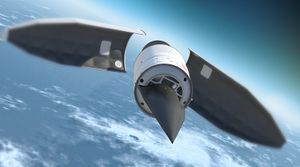Last week, China has yet again successfully tested the developmental DF-ZF (previously known as WU-14) hypersonic glide vehicle (HGV), Bill Gertz over at The Washington Free Beacon reveals.
The test of the high-speed maneuvering warhead took place at the Wuzhai missile test center in central China’s Shanxi Province, some 250 miles (400 kilometers) southwest of Beijing.
“The maneuvering glider, traveling at several thousand miles per hour, was tracked by satellites as it flew west along the edge of the atmosphere to an impact area in the western part of the country,” Gertz reports.
The test has also been confirmed by the People’s Daily Online: “China has successfully completed a seventh flight test of its new hypersonic glide vehicle last week in its northern central Shanxi province.”
China has now tested the new weapon a total of seven times. The last launch of the DF-ZF– an ultra-high-speed missile purportedly capable of penetrating U.S. air defense systems based on interceptor missiles–occurred in November in November 2015 (See: “China Tests New Hypersonic Weapon”).
The DF-ZF HGV can allegedly reach speeds between Mach 5 and Mach 10, or 6,173 kilometers (3,836 miles) per hour and 12,359 kilometers (7,680 miles) per hour. I previously explained the sequence of a DF-ZF HGV launch:
The DF-ZF warhead is carried to the boundary between space and Earth’s atmosphere, approximately 100 km above the ground, by a large ballistic missile booster.
Once it reaches that height, it begins to glide in a relatively flat trajectory by executing a pull-up maneuver and accelerates to speeds of up to Mach 10.
The gliding phase enables the HGV not only to maneuver aerodynamically – performing evasive actions and evading interception – but also extends the range of the missile.
U.S. defense officials confirmed in June 2015 that the DF-ZF performed “extreme maneuvers” during a flight test.
What makes the DF-ZF particularly dangerous is that as of now there is no adequate defense against the new hypersonic weapon as I reported last year:
[U]nlike conventional reentry vehicles, which descend through the atmosphere on a predictable ballistic trajectory, hypersonic glider vehicles are almost impossible to intercept by conventional missile defense systems, which track incoming objects via satellite sensors and ground and sea radar.
Once deployed, the DF-ZF warhead mounted on intercontinental ballistic missile (e.g., the DF-41) would give the PLA a global strike capability. The HGV could also be mounted on short and intermedium-range anti-ship ballistic missiles capable of penetrating the layered air defenses of a U.S. carrier strike group.
A weakness in high-performance computing is allegedly plaguing China’s DF-ZF program and slows down Chinese efforts to design hypersonic weapons, according to some media reports:
[T]he lack of computing power slowed down scientists’ effort to create and verify innovative designs for hypersonic weapons (…). A good supercomputer could be used as a “digital wind tunnel” to quickly develop prototypes for test flights and help the decision on the choice of models for production.
U.S. super computers are currently ten times faster than their Chinese counterparts. “Without faster computers, Chinese researchers would have to waste time breaking down sophisticated calculations into smaller jobs so they could be run on less advanced machines,” the South China Morning Post reported last year.
Experts assume that that China is still about two decades away from fielding a missile with an operational DF-ZF warhead capable of hitting a moving target, although some analysts believe that the new weapon could be deployed as early as 2020.

































